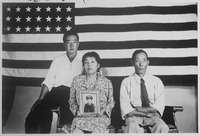Federal Correctional Institution, Seagoville
 | |
| Location | Seagoville, Texas |
|---|---|
| Status | Operational |
| Security class | Low-security (with minimum-security prison camp) |
| Population | 1,800 (170 in prison camp) |
| Managed by | Federal Bureau of Prisons |
| Warden | Eddy Mejia |
The Federal Correctional Institution, Seagoville (FCI Seagoville) is a low-security United States federal prison for male inmates in Seagoville, Texas in the Dallas-Fort Worth metropolitan area. It is operated by the Federal Bureau of Prisons, a division of the United States Department of Justice. The facility includes a detention center for male offenders and an adjacent satellite prison camp that houses minimum security-male offenders.
FCI Seagoville is located 11 miles (18 km) southeast of Downtown Dallas.[1]
History
The Federal Reformatory for Women in Seagoville opened on October 10, 1940. After the attack on Pearl Harbor, the government converted the center into a Federal Detention Station, monitored by the Immigration and Naturalization Service, that housed people of Japanese, German and Italian descent who were classified as "enemy aliens," including women deported from Latin America into U.S. custody[2][3] Many of the Latin American internees had been classified officially as "voluntary internees" because they had chosen to leave their home countries after their husbands had been deported to the U.S., however, their choice was in many cases motivated by the difficulties of supporting themselves and their families alone.[3] Internees at Seagoville published a German language newsletter called the Sägedorfer Fliegende Blätter.[4] Beginning in June 1943, the State Department arranged for the deportation of many of the internees to Japan and Germany, which helped decrease the population as authorities prepared to transfer the remaining detainees to Crystal City, Texas.[3] Seagoville held a total of some 650-700 people, and was closed in June 1945.[3][5]
After World War II ended, on June 25, 1945 the prison became a facility for minimum security male offenders. In 1969 the facility's mission changed to that of housing young male offenders sentenced under the Youth Corrections Act.[6] At the time the maximum age of the prisoners was 27.[7]
In 1979 the facility's mission changed into that of a Federal Prison Camp. In 1981 a perimeter fence was installed and the facility became a Federal Correctional Institution. The adjacent Federal Detention Center opened in 1996. FDC Seagoville celebrated its 60th anniversary on October 10, 2000.[6]
Facility
The prison facility is located on an 830-acre (340 ha) tract. Built for $1.8 million, it occupies a portion of the acreage. In World War II single detainees occupied dormitories while couples resided in "Victory Huts", prefabricated one room buildings with measurements of 18 square feet (1.7 m2) each.[8]
Notable incidents
On November 8, 2012, 27-year-old John Hall, an inmate at FCI Seagoville, pleaded guilty to violating the Matthew Shepard and James Byrd, Jr. Hate Crimes Prevention Act for assaulting a fellow inmate whom he believed to be gay. Hall admitted that on December 20, 2011, he repeatedly punched and kicked the victim, whom the Department of Justice did not identify, while calling the victim homosexual slurs. The victim sustained multiple lacerations to his face and fractured teeth as a result of Hall’s unprovoked attack. On March 14, 2013, Hall was sentenced to an additional 71 months in prison for the attack, which is to be served concurrently.[9]
Notable inmates (current and former)
| Inmate | Register Number | Status | Details |
|---|---|---|---|
| Jacques Roy | 44132-177 | Currently awaiting trial.[10] | Physician; indicted in 2012 for conspiracy to commit healthcare fraud for allegedly masterminding the largest healthcare fraud in US history, which involved 11,000 patients and resulted in $375 million being fraudulently billed to Medicare and Medicaid.[11][12] |
See also
References
- ↑ "FCI Seagoville". Federal Bureau of Prisons.
- ↑ Seagoville, Texas from the Handbook of Texas Online
- 1 2 3 4 Mak, Stephen. "Seogoville (detention facility)" Densho Encyclopedia (accessed 17 Jun 2014).
- ↑ "Seagoville Internee Newspaper: Sägedorfer Fliegende Blätter" (PDF). The Freedom of Information Times (in German). Retrieved 2014-02-06.
- ↑ Texas State Historical Association (TSHA). "World War II Internment Camps". The Handbook of Texas Online. Retrieved 2014-02-06.
- 1 2 "SEAGOVILLE CELEBRATES 60th ANNIVERSARY." Federal Bureau of Prisons. Tuesday February 11, 2003. Retrieved on May 29, 2010.
- ↑ "Behind Bars in Texas: Not All Prisons, Are the Same." Texas Monthly. Emmis Communications, March 1974. Volume 2, No. 3. ISSN 0148-7736. START: p. 42. CITED: p. 42.
- ↑ Mangione, Jerre. "Concentration Camps—American Style." In: DiStasi, Lawrence. Una Storia Segreta: The Secret History of Italian American Evacuation and Internment During World War II. Heyday Books, 2001. ISBN 1890771406, 9781890771409. START: p. 117. CITED: p. 121.
- ↑ "Aryan Brotherhood Inmate Sentenced for Federal Hate Crime for Assaulting Fellow Inmate". U.S. Department of Justice. Retrieved 10 June 2014.
- ↑ Landers, Jim (February 17, 2014). "Dallas area home to huge health care frauds". The Dallas Morning News. Retrieved 13 October 2015.
- ↑ "Dallas Doctor Arrested For Alleged Role In Nearly $375 Million Health Care Fraud Scheme". US Department of Justice. February 28, 2012. Retrieved 14 May 2013.
- ↑ Fink, Jack (February 28, 2012). "Rockwall Doctor Charged In Biggest U.S. Healthcare Fraud Ever". CBS. Retrieved 14 May 2013.
External links
| Wikimedia Commons has media related to Federal Correctional Institution, Seagoville. |
- Map of BOP Prisons
- BOP: FCI Seagoville
- WORLD WAR II INTERNMENT CAMPS from the Handbook of Texas Online
Coordinates: 32°39′18″N 96°34′03″W / 32.65500°N 96.56750°W
